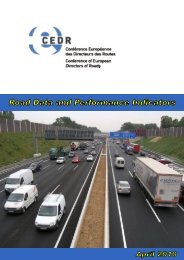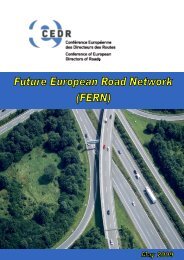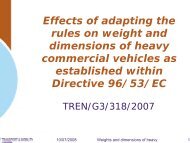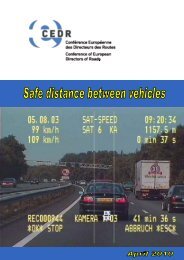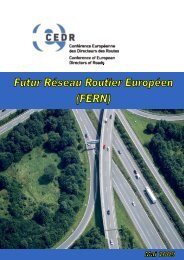Best Practice for Cost-Effective Road Safety Infrastructure - CEDR
Best Practice for Cost-Effective Road Safety Infrastructure - CEDR
Best Practice for Cost-Effective Road Safety Infrastructure - CEDR
Create successful ePaper yourself
Turn your PDF publications into a flip-book with our unique Google optimized e-Paper software.
Page 26 / 28<br />
The maximum safety effect achieved by introducing traffic signals at junctions is again<br />
associated with 4-leg junction treatments. Important safety effects are also achieved by<br />
upgrading traffic signals. However, this is so only when the upgrade leads to more efficient<br />
accommodation or separation of traffic flows. More specifically, the maximum safety effects of<br />
traffic signal upgrades result from the re-timing of traffic signals, the introduction of separate<br />
pedestrian phases, or the introduction of separate left-turn phases. It is emphasised that any<br />
modification in traffic signal operation that involves the introduction of mixed phases (e.g. mixed<br />
pedestrian phase, right-turn permission during red signal) may result in a significant increase in<br />
road accidents. Nowadays, in most countries, such investments are rarely applied. In any case,<br />
the positive safety effects noted above are associated with very satisfactory cost-benefit ratios.<br />
It is very interesting to note that traffic-calming schemes always appear to have positive safety<br />
effects and satisfactory cost-effectiveness, regardless of the type or the extent of these<br />
treatments. This is particularly impressive when considering that traffic-calming schemes may<br />
range from simple speed humps on a few roads (at low cost), to area-wide combinations of<br />
several treatments (with obviously higher costs). Nevertheless, no pattern was found to justify<br />
the conclusion that more extensive treatments have higher safety effects or are more costeffective:<br />
there<strong>for</strong>e traffic calming schemes can be considered a priority safety investment <strong>for</strong><br />
urban and residential areas.<br />
Based on the outcomes of the analysis, it is obvious that the overall cost-effectiveness of a<br />
road safety infrastructure investment is not always in direct correlation with the safety<br />
effect. Several interesting results are demonstrated in Table 5.1. Roundabouts have very high<br />
safety effects, which are not directly reflected in the cost-benefit ratios available. On the other<br />
hand, the cost-benefit ratios of traffic signals are higher than those of roundabouts, although the<br />
safety effects of traffic signals are much less impressive. In this case, a comparison of costbenefit<br />
ratios only might lead the less-in<strong>for</strong>med reader to the misleading conclusion that traffic<br />
signals are more efficient than roundabouts, whereas what is indicated is that they are simply<br />
more cost-effective. Consequently, it is recommended that cost-benefit ratios and safety<br />
effects are always examined in conjunction with each other in order to identify the optimum<br />
solution <strong>for</strong> a specific road safety problem in specific conditions and with specific objectives.<br />
It should be stressed that the above ranges of results can by no means be considered to be<br />
applicable to every application of these investments. Although the cases examined were<br />
relatively representative and the results quite consistent, it is always possible that the<br />
particularities of setting, context, and implementation features of a specific case may produce<br />
results with varying degrees of difference.<br />
Furthermore, in the present synthesis, the five most promising investments were examined<br />
individually. However, important interrelations exist among these most promising<br />
investments. For instance, roadside treatments, junction layout treatments, and speed limitrelated<br />
interventions could be considered a main set of most promising investments on<br />
interurban and rural roads. On the other hand, traffic calming, junction layout, and traffic control<br />
at junctions may be considered a main set of most promising investments in urban areas. In any<br />
case, additional investments that are not included among the five most promising investments<br />
may also be necessary.<br />
<strong>Best</strong> practice <strong>for</strong> cost-effective road safety infrastructure investments



